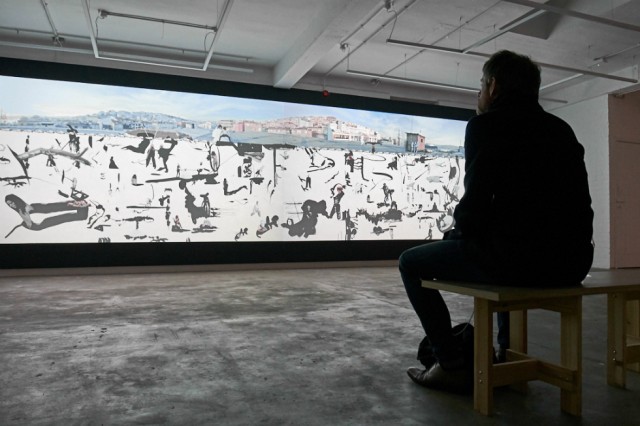Place To Place:
Liverpool Biennial in Hull

The Liverpool Biennial touring programme arrived at Hull’s Humber Street Gallery last month with exhibition Place To Place, which groups together works by Annie Pootoogook, Suki Seokyeong Kang and Inci Eviner. Here, Lauren Saunders and Jill Howitt discuss the new presentation…
Lauren Saunders: What did you think of the title, ‘Place to Place’?
Jill Howitt: I wondered how the work would be in Hull compared to Liverpool, where the artists were dispersed across different venues. I imagined the work travelling the M62, a transmigration route as well as the site for Artranspennine [a multi-venue exhibition of contemporary art in the north of England that first took place in 1998]. I thought about how culture connects Liverpool and Hull; both ports and cities of culture on opposite edges of the country.
LS: I tend to go into exhibitions knowing relatively little so I can experience the work ‘as-is’ and reflect in the moment, so I wasn’t sure what to expect… I simply went in excited to see work by other female artists who also use drawing in their practice. What expectations did you have?
JH: I went in thinking about places and identity. How place shapes who we are and the role of culture to bridge our experiences. These artists come from such different backgrounds. But I’d also seen Annie Pootoogook’s memorable work at the Biennial – so I was interested to see how her drawings worked at Humber Street. I liked the lay out with one floor per artist; I could immerse myself in each body of work and then draw connections.
LS: Yes, I appreciated the distinct experiences on each floor… I needed the space to create responses to each artist, which then allowed me to make parallels between them. I noticed the different ways they used line – from Suki Seokyeong Kang’s theatrical and almost Schlemmer-esque lines that navigated through space, Pootoogook’s careful figurative drawings on heavy paper to Inci Eviner’s metamorphic and energetic brushwork on screen.

JH: And I was drawn to space; pictorial and viewing space. Firstly Kang’s mats, representing the minimum space required for each person in society; spilling off the walls, vertical, draped and laid horizontally, punctuating and animating the gallery space. Then Pootoogook’s flattened claustrophobic interiors, bordering and in dialogue with the larger breathing space of the next gallery room. Finally, Eviner’s fluid ink drawings spaced out and layered along one long white wall and brought to life on the opposite one. I found some of the details mesmerising but disturbing….
LS. Yes, it had a strong Garden of Earthly Delights feel about it, I thought. Except the twerking – I don’t remember that in Bosch’s version! I empathised with the gibbering female voices of the accompanying chorus… Writhing, dancing, catfighting women in heels and restrained sexualised damsels lost along their repetitive, predetermined paths…
JH. Each trapped in their allotted space endlessly performing their athletic, frenzied, floating, crawling movements….
LS. The black ink strokes are animated: they spring to life.
JH. So there’s a kind of interchangeability between the gestures of Eviner’s mark-making and the women’s movements? For me, this conjured up Yves Klein’s Anthropometries, where he used naked women as human paint brushes. In fact two of the characters were covering each other in something which could have been blue pigment. Does this reflect a reductive, objectifying male gaze?

LS. So like a male-dominated heaven but a female hell…
JH: …both beautiful and ugly? But how do the other two artists reflect on female experience?
LS: In Kang’s work I discovered a rhythmic humdrum of domestic daily life, within the boundaries given to women by their own cultures. The coded language of the mats suggested something about the complexity of a rich, dutiful tradition that, as an outsider, I’ll never fully comprehend. That feeling of outsider-ness travelled with me upstairs to Pootoogook’s floor – the first image I saw was of a family butchering a seal. I became conscious of tension between the familiar and unfamiliar… I laughed at the recognisable playfulness of family life, smirked at the porn on TV and was saddened by scenes depicting domestic violence and alcoholism.
JH. Yes I found the detailed but childlike rendering of abuse heart-breaking. It both reminds us of how children suffer from domestic abuse and how victims are made childlike in their lack of power.
LS. The suffering really affected me. Kang’s work had already got me thinking about traditional expectations of women, and Pootoogook’s unromantic gaze made it feel more real.
JH. Between them perhaps these artists remind us that the ordinary, the marvellous and the terrible coexist in everyday life.
LS. It will be interesting to see what kinds of conversation this exhibition provokes in Hull rather than the Biennial audience in Liverpool?
JH. I hope there will be a positive response – this is accessible work that can be approached from different perspectives. It is issue-based and performative with a kind of technical accessibility that local audiences have experienced at Ground, Artlink and during the City of Culture year.
Lauren Saunders and Jill Howitt are editors of The Critical Fish, a new Visual Arts Journal based in Hull
Place To Place is at Humber Street Gallery until 31 March as part of the Liverpool Biennial Touring Programme
Images from top: Suki Seokyeong Kang; Annie Pootoogook; Inci Eviner, courtesy Rob Battersby





